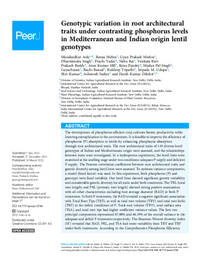Genotypic variation in root architectural traits under contrasting phosphorus levels in Mediterranean and Indian origin lentil genotypes

Authors:
The development of phosphorus-efficient crop cultivars boosts productivity while lowering eutrophication in the environment. It is feasible to improve the efficiency of phosphorus (P) absorption in lentils by enhancing phosphorus absorption through root architectural traits. The root architectural traits of 110 diverse lentil genotypes of Indian and Mediterranean origin were assessed, and the relationships between traits were investigated. In a hydroponics experiment, the lentil lines were examined at the seedling stage under two conditions: adequate P supply and deficient P supply. The Pearson correlation coefficients between root architectural traits and genetic diversity among lentil lines were assessed. To estimate variance components, a model (fixed factor) was used. In this experiment, both phosphorus (P) and genotype were fixed variables. Our lentil lines showed significant genetic variability and considerable genetic diversity for all traits under both treatments. The TRL (total root length) and PRL (primary root length) showed strong positive associations with all other characteristics excluding root average diameter (RAD) in both P treatments. In both P treatments, the RAD revealed a negative significant association with Total Root Tips (TRT), as well as total root volume (TRV) and total root forks (TRF) in the deficit conditions of P. Total root volume (TRV), total surface area (TSA), and total root tips had higher coefficient variance values. The first two principal components represented 67.88% and 66.19% of the overall variance in the adequate and deficit P treatments respectively. The Shannon-Weaver diversity index (H′) revealed that RAD, PRL, and TSA had more variability than TRT and TRF under both treatments. According to the Comprehensive Phosphorus Efficiency Measure (CPEM), the best five highly efficient genotypes are PLL 18-09, PLS 18-01, PLL 18-25, PLS 18-23, and PLL 18-07, while IG112131, P560206, IG334, L11-231, and PLS18-67 are highly inefficient genotypes. The above contrasting diverse lentil genotypes can be utilized to produce P-efficient lentil cultivars. The lentil germplasm with potentially favorable root traits can be suggested to evaluated for other abiotic stress to use them in crop improvement programme. The scientific breakthroughs in root trait phenotyping have improved the chances of establishing trait–allele relationships. As a result, genotype-to-phenotype connections can be predicted and verified with exceptional accuracy, making it easier to find and incorporate favourable nutrition-related genes/QTLs in to breeding programme.
